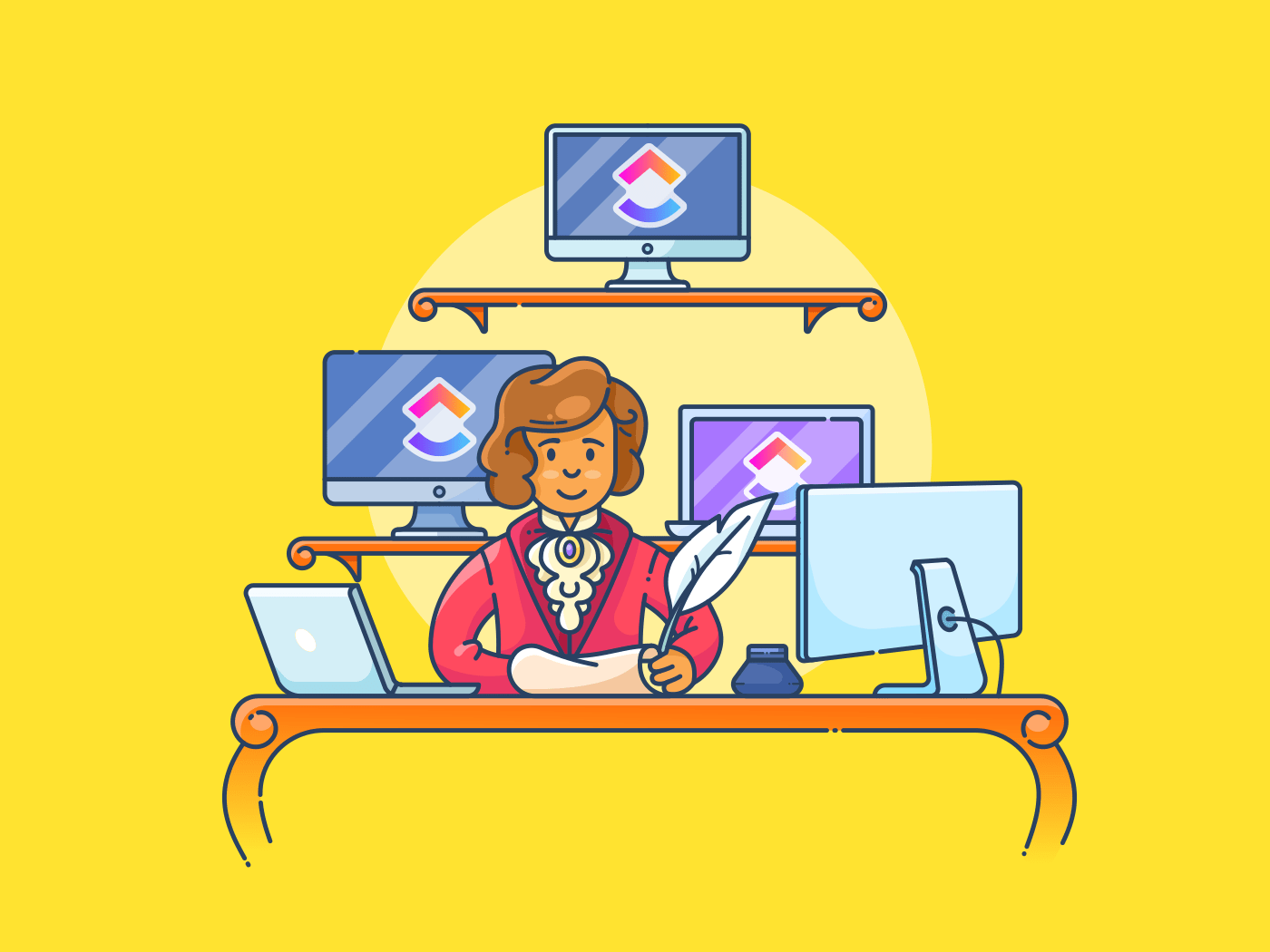بعد مرور 24 ساعة، ننسى ما يصل إلى 40% من المعلومات الجديدة التي نتعلمها. ولكن يمكننا الاحتفاظ بما يصل إلى 100% من ذاكرتنا باستخدام أداة بسيطة: تدوين الملاحظات.
في دراسة أجريت عام 2021 في مجلة علم النفس التجريبي استطاع المشاركون الذين دوّنوا الملاحظات أن يتذكروا المعلومات بشكل أفضل من أولئك الذين لم يفعلوا ذلك أو التقطوا صورًا للمحاضرات على هواتفهم. عندما لا نحاول الاحتفاظ بالمعلومات، تنخفض ذاكرتنا عن تلك التجربة تدريجيًا حتى لا نتذكر سوى القليل - أو لا نتذكر شيئًا - عنها.
لحسن الحظ، يساعد تدوين الملاحظات في الاحتفاظ بالذاكرة من خلال الانخراط بنشاط في المادة للربط بين المعرفة الجديدة والخبرات السابقة. 🔗
تعتمد استراتيجية تدوين الملاحظات الأكثر فاعلية بالنسبة لك على نوع المحتوى أو المعلومات التي تجمعها، وكيفية تقييمك لها، والوقت المتاح لك للاحتفاظ بها.
يجب أن تسمح لك العملية التي تتبعها بتدوين الملاحظات المثمرة في أي بيئة وتشجعك على التعلم والاحتفاظ بالمعلومات بكفاءة. قام ClickUp بتنسيق قائمة ببعض الاستراتيجيات المجربة والحقيقية لتحسين تدوين الملاحظات الافتراضية والشخصية وجعلها أكثر إنتاجية.
تابع القراءة لتتعرف على أفضل خمس استراتيجيات لمساعدة أي شخص على تدوين ملاحظات أفضل وأكثر إنتاجية، سواء كنت تستمع إلى بودكاست، أو تتابع محاضرة أو تشاهد فيلمًا وثائقيًا.
نلقي نظرة متعمقة على أكثر من اثنتي عشرة من
_أفضل تطبيقات تدوين الملاحظات المجانية_
من 2022 وتفصيل إمكانيات ونقاط ضعف كل منها._
1. جرب طريقة تقليدية لتدوين الملاحظات

عبر جاكوب لوند/ شاترستوك
تعتبر الطرق التقليدية لتدوين الملاحظات، مثل طريقتَي كورنيل والملاكمة، من أكثر الطرق إنتاجية واستخداماً على نطاق واسع. أما طريقة كورنيل التي طورها والتر باوك في الخمسينيات من القرن العشرين، تقسم الملاحظات إلى ثلاثة أجزاء: الإشارة، والملاحظات، والملخص. تساعد هذه الأقسام على تحسين قدرتك على حفظ المعلومات والاحتفاظ بها بطريقة منظمة.
تقوم طريقة الملاكمة بتجميع أجزاء مختلفة من المعلومات في مربعات صغيرة وتسميتها أو تضمين فكرة أوسع في أعلى كل مربع. تحافظ هذه الطريقة على الإيجاز وتعمل بشكل جيد مع الملاحظات الرقمية.
من الأسهل إعادة ترتيب الأقسام ونقلها بعد الدروس. يمكن أن تكون الطرق التقليدية الأخرى، مثل التدوين اليومي النقطي أو طريقة المخطط التفصيلي، فعالة أيضًا.
2. استخدام أدوات الذكاء الاصطناعي لتدوين الملاحظات

عبر Yakobchuk Viacheslav/ Shutterstock أدوات تدوين الملاحظات بالذكاء الاصطناعي تخلق طريقًا سهلاً نحو إعطاء أي تجربة تعليمية اهتمامك الكامل. يمكنك المساهمة بشكل كامل في الدروس والاجتماعات والاستغراق كما تريد دون الكثير من الكتابة المملة.
ظاهريًا يبدو أن أدوات الذكاء الاصطناعي تنسخ الكلمات إلى ملاحظات ببساطة . ولكنها أيضًا تمحو احتمالية الخطأ البشري، وتوفر نصوصًا مختومة بختم زمني يمكن البحث فيها، وتحول الأفكار إلى مهام يمكن تتبعها، وتوفر الدروس بلغات عديدة.
حافظ على التنظيم والتميز مع ملاحظات الاجتماعات الرائعة. اطّلع على قوالب مجانية لمذكرات الاجتماعات وقائمة التدقيق، ومنصة إدارة المهام._
5. تدوين الملاحظات بشكل تعاوني

عبر كانفا
يمكن أن تساعد الكتابة بشكل تعاوني في مجموعات أو مع شركاء في تلقي الجميع لوجهات نظر متعددة للدرس وتقييم الأفكار في الموضوع بشكل نقدي. في التدوين التعاوني للملاحظات، يتم تقسيم المهام بحيث يمكن لكل شخص أن يتناول عنصرًا مختلفًا من عناصر التركيز - سواء كان الملخص أو الإشارة أو الأفكار القابلة للتنفيذ. تدوين الملاحظات التعاوني يمكن أن يعزز التفاعل مع الموضوع ويخلق مساحة لأسئلة أفضل وأعمق. كما يمكن لهذا النمط من تدوين الملاحظات أن يساعد أعضاء المجموعة على تتبع ما حدث أثناء النشاط التعليمي للرجوع إليه لاحقًا.
ارتقِ بمهاراتك في تدوين الملاحظات إلى المستوى التالي
هناك العديد من الطرق المختلفة لتدوين الملاحظات، وتعتمد الاستراتيجيات الأكثر فعالية على الظروف والأهداف التي تريد تحقيقها.
سواء كنت تحتاج إلى تدوين الملاحظات للعمل أو المدرسة أو تبحث ببساطة عن طرق أفضل لتدوين الملاحظات السريعة وكتابة ملاحظات مفصلة للاجتماعات، يمكن أن يساعدك ClickUp في أن تصبح مدونًا نهمًا للملاحظات بفضل ميزاته القوية والمرنة في تدوين الملاحظات مثل المفكرة, مستندات ClickUp و اللوحات البيضاء .
مدمجة في منصة إدارة المشاريع ، تتيح لك ميزات تدوين الملاحظات هذه إمكانية تدوين الملاحظات وتخزينها مع عملك. ناهيك عن أنها قابلة للتخصيص بشكل كامل - قم بتنسيق ملاحظاتك وتنظيمها بالطريقة التي تريدها لتلبية احتياجات مشروعك وتفضيلاتك الشخصية. جرب ClickUp مجانًا اليوم، _وانتقل بمهاراتك في تدوين الملاحظات إلى المستوى التالي!
الكاتب الضيف:

